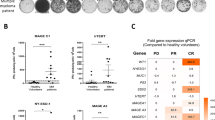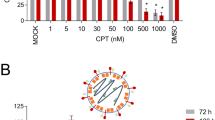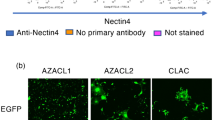Abstract
Oncolytic viruses are promising cytoreductive agents for cancer treatment but extensive human testing will be required before they are made commercially available. Here, we investigated the oncolytic potential of two commercially available live attenuated vaccines, Moraten measles and Jeryl-Lynn mumps, in a murine model of intraperitoneal human ovarian cancer and compared their efficacies against a recombinant oncolytic measles virus (MV-CEA) that is being tested in a phase I clinical trial. The common feature of these viruses is that they express hemagglutinin and fusion therapeutic proteins that can induce extensive fusion of the infected cell with its neighbors, resulting in death of the cell monolayer. In vitro, the three viruses caused intercellular fusion in human ovarian cancer cells but with marked differences in fusion kinetics. MV-CEA was the fastest followed by Jeryl-Lynn mumps virus while Moraten measles virus was the slowest, although all viruses eventually caused comparable cell death 6 days postinfection. Tumor-bearing mice treated with 106 or 107 pfu (one thousand times the vaccine dose) of each of the three viruses responded favorably to therapy with significant prolongations in survival. All three viruses demonstrated equivalent antitumor potency. Commercially available Moraten measles and Jeryl-Lynn mumps vaccines warrant further investigation as potential anticancer agents.
This is a preview of subscription content, access via your institution
Access options
Subscribe to this journal
Receive 12 print issues and online access
$259.00 per year
only $21.58 per issue
Buy this article
- Purchase on Springer Link
- Instant access to full article PDF
Prices may be subject to local taxes which are calculated during checkout


Similar content being viewed by others
References
Jemal A, Tiwari RC, Murray T, et al. American Cancer Society. Cancer statistics, 2004. CA Cancer J Clin. 2004;54:8–29.
NIH consensus conference. Ovarian cancer. Screening, treatment and follow-up. NIH Consensus Development Panel on Ovarian Cancer. JAMA. 1995;273:493–497.
Stuart GC . First-line treatment regimens and the role of consolidation therapy in advanced ovarian cancer. Gynecol Oncol. 2003;90:S8–S15.
Russell SJ . Replicating vectors for cancer therapy: a question of strategy. Semin Cancer Biol. 1994;5:437–443.
Kirn D, Martuza RL, Zwiebel J . Replication-selective virotherapy for cancer: biological principles, risk management and future directions. Nat Med. 2001;7:781–787.
Bell JC, Garson KA, Lichty BD, et al. Oncolytic viruses: programmable tumour hunters. Curr Gene Ther. 2002;2:243–254.
Everts B, Poel HG . Replication-selective oncolytic viruses in the treatment of cancer. Cancer Gene Ther. 2004 [Epub ahead of print].
Peng KW, TenEyck CJ, Galanis E, et al. Intraperitoneal therapy of ovarian cancer using an engineered measles virus. Cancer Res. 2002;62:4656–4662.
Peng KW, Facteau S, Wegman T, O'Kane D, Russell SJ . Non-invasive in vivo monitoring of trackable viruses expressing soluble marker peptides. Nat Med. 2002;8:527–531.
Griffin D . Measles Virus. In: Fielding B, Knipe D, Howley P, eds. Fields Virology. 4th ed. Philadelphia: Lippincott-Raven Publishers; 2001: 1401–1441.
Galanis E, Bateman A, Johnson K, et al. Use of viral fusogenic membrane glycoproteins as novel therapeutic transgenes in gliomas. Hum Gene Ther. 2001;12:811–821.
Esolen LM, Park SW, Hardwick JM, Griffin DE . Apoptosis as a cause of death in measles virus-infected cells. J Virol. 1995;69:3955–3958.
Nakamura T, Peng KW, Vongpunsawad S, et al. Antibody-targeted cell fusion. Nat Biotechnol. 2004;22:331–336.
Radecke F, Spielhofer P, Schneider H, et al. Rescue of measles viruses from cloned DNA. EMBO J. 1995;14:5773–5784.
Rota JS, Wang ZD, Rota PA, et al. Comparison of sequences of the H, F, and N coding genes of measles virus vaccine strains. Virus Res. 1994;31:317–330.
Parks CL, Lerch RA, Walpita P, Wang HP, Sidhu MS, Udem SA . Comparison of predicted amino acid sequences of measles virus strains in the Edmonston vaccine lineage. J Virol. 2001;75:910–920.
Tatsuo H, Ono N, Tanaka K, Yanagi Y . SLAM (CDw150) is a cellular receptor for measles virus. Nature. 2000;406:893–897.
Dorig RE, Marcil A, Chopra A, Richardson CD . The human CD46 molecule is a receptor for measles virus (Edmonston strain). Cell. 1993;75:295–305.
Naniche D, Varior-Krishnan G, Cervoni F, et al. Human membrane cofactor protein (CD46) acts as a cellular receptor for measles virus. J Virol. 1993;67:6025–6032.
Bjorge L, Hakulinen J, Wahlstrom T, Matre R, Meri S . Complement-regulatory proteins in ovarian malignancies. Int J Cancer. 1997;70:14–25.
Lamb RA, Kolakofsky D . Paramyxoviridae: the viruses and their replication. In: Fielding B, Knipe D, Howley P, eds. Fields Virology. 4th edn. Philadelphia: Lippincott-Raven Publishers; 2001: 1305–1340.
Carbone KM, Wolinsky JS . Mumps Virus. In: Fielding B, Knipe D, Howley P, eds. Fields Virology. 4th edn. Philadelphia: Lippincott-Raven Publishers; 2001: 1381–1400.
Conover CA, Hartmann LC, Bradley S, et al. Biological characterization of human epithelial ovarian carcinoma cells in primary culture: the insulin-like growth factor system. Exp Cell Res. 1998;238:439–449.
Cathomen T, Naim HY, Cattaneo R . Measles viruses with altered envelope protein cytoplasmic tails gain cell fusion competence. J Virol. 1998;72:1224–1234.
Phuong LK, Allen C, Peng KW, et al. Use of a vaccine strain of measles virus genetically engineered to produce carcinoembryonic antigen as a novel therapeutic agent against glioblastoma multiforme. Cancer Res. 2003;63:2462–2469.
Anderson BD, Nakamura T, Russell SJ, et al. High CD46 receptor density determines preferential killing of tumor cells by oncolytic measles virus. Cancer Res. 2004;64:4919–4926.
Lin YL, Mettling C, Portales P, et al. Cell surface CCR5 density determines the postentry efficiency of R5 HIV-1 infection. Proc Natl Acad Sci USA. 2002;99:15590–15595.
Kozak SL, Platt EJ, Madani N, et al. CD4, CXCR-4, and CCR-5 dependencies for infections by primary patient and laboratory-adapted isolates of human immunodeficiency virus type 1. J Virol. 1997;71:873–882.
Li Y, Pong RC, Bergelson JM, et al. Loss of adenoviral receptor expression in human bladder cancer cells: a potential impact on the efficacy of gene therapy. Cancer Res. 1999;59:325–330.
Cripe TP, Dunphy EJ, Holub AD, et al. Fiber knob modifications overcome low, heterogeneous expression of the coxsackievirus-adenovirus receptor that limits adenovirus gene transfer and oncolysis for human rhabdomyosarcoma cells. Cancer Res. 2001;61:2953–2960.
Kanerva A, Wang M, Bauerschmitz GJ, et al. Gene transfer to ovarian cancer versus normal tissues with fiber-modified adenoviruses. Mol Ther. 2002;5:695–704.
Wickham TJ . Targeting adenovirus. Gene Ther. 2000;7:110–114.
Sillanaukee P, Ponnio M, Jaaskelainen IP . Occurrence of sialic acids in healthy humans and different disorders. Eur J Clin Invest. 1999;29:413–425.
Donin N, Jurianz K, Ziporen L, et al. Complement resistance of human carcinoma cells depends on membrane regulatory proteins, protein kinases and sialic acid. Clin Exp Immunol. 2003;131:254–263.
Liszewski MK, Post TW, Atkinson JP . Membrane cofactor protein (MCP or CD46): newest member of the regulators of complement activation gene cluster. Annu Rev Immunol. 1991;9:431–455.
Gorter A, Meri S . Immune evasion of tumor cells using membrane-bound complement regulatory proteins. Immunol Today. 1999;20:576–582.
Fishelson Z, Donin N, Zell S, et al. Obstacles to cancer immunotherapy: expression of membrane complement regulatory proteins (mCRPs) in tumors. Mol Immunol. 2003;40 (2–4):109–123.
Russell SJ . RNA viruses as virotherapy agents. Cancer Gene Ther. 2002;9:961–966.
Yoon TK, Shichinohe T, Laquerre S, et al. Selectively replicating adenoviruses for oncolytic therapy. Curr Cancer Drug Targets. 2001;1:85–107.
Cornelis JJ, Salome N, Dinsart C, Rommelaere J . Vectors based on autonomous parvoviruses: novel tools to treat cancer? J Gene Med. 2004;6 (Suppl 1):S193–S202.
Giedlin MA, Cook DN, Dubensky Jr TW . Vesicular stomatitis virus: an exciting new therapeutic oncolytic virus candidate for cancer or just another chapter from Field's Virology? Cancer Cell. 2003;4:241–243.
Fulci G, Chiocca EA . Oncolytic viruses for the therapy of brain tumors and other solid malignancies: a review. Front Biosci. 2003;8:e346–e360.
Cranshaw ML, Leak LV . Milky spots of the omentum: a source of peritoneal cells in the normal and stimulated animal. Arch Histol Cytol. 1990;53 (Suppl):165–177.
Wijffels JF, Hendrickx RJ, Steenbergen JJ, et al. Milky spots in the mouse omentum may play an important role in the origin of peritoneal macrophages. Res Immunol. 1992;143:401–409.
Hagiwara A, Takahashi T, Sawai K, et al. Milky spots as the implantation site for malignant cells in peritoneal dissemination in mice. Cancer Res. 1993;53:687–692.
Lopes CAM, Gupta A, Koppe MJ, et al. Metastatic pattern of CC531 colon carcinoma cells in the abdominal cavity: an experimental model of peritoneal carcinomatosis in rats. Eur J Surg Oncol. 2001;27:359–363.
Asada T . Treatment of human cancer with mumps virus. Cancer. 1974;34:1907–1928.
Okuno Y, Asada T, Yamanishi K, et al. Studies on the use of mumps virus for treatment of human cancer. Biken J. 1978;21:37–49.
Shimizu Y, Hasumi K, Okudaira Y, et al. Immunotherapy of advanced gynecologic cancer patients utilizing mumps virus. Cancer Detect Prev. 1988;12:487–495.
Rubin SA, Pletnikov M, Taffs R, et al. Evaluation of a neonatal rat model for prediction of mumps virus neurovirulence in humans. J Virol. 2000;74:5382–5384.
Saika S, Kidokoro M, Aoki A, et al. Neurovirulence of mumps virus: intraspinal inoculation test in marmosets. Biologicals. 2004;32:147–152.
Dingli D, Peng KW, Harvey ME, et al. Image-guided radiovirotherapy for multiple myeloma using a recombinant measles virus expressing the thyroidal sodium iodide symporter. Blood. 2004;103:1641–1646.
Acknowledgements
This study was funded by Grants from the NIH HL66958-04P4 and CA100634-01, Mayo Foundation, Harold W Siebens Foundation and George W Eisenberg Foundation.
Author information
Authors and Affiliations
Corresponding author
Rights and permissions
About this article
Cite this article
Myers, R., Greiner, S., Harvey, M. et al. Oncolytic activities of approved mumps and measles vaccines for therapy of ovarian cancer. Cancer Gene Ther 12, 593–599 (2005). https://doi.org/10.1038/sj.cgt.7700823
Received:
Published:
Issue Date:
DOI: https://doi.org/10.1038/sj.cgt.7700823
Keywords
This article is cited by
-
Regression of solid breast tumours in mice by Newcastle disease virus is associated with production of apoptosis related-cytokines
BMC Cancer (2019)
-
Chemovirotherapeutic Treatment Using Camptothecin Enhances Oncolytic Measles Virus-Mediated Killing of Breast Cancer Cells
Scientific Reports (2019)
-
Oncolysis by paramyxoviruses: multiple mechanisms contribute to therapeutic efficiency
Molecular Therapy - Oncolytics (2015)
-
Oncolysis by paramyxoviruses: preclinical and clinical studies
Molecular Therapy - Oncolytics (2015)
-
Inactivated Sendai virus strain Tianjin, a novel genotype of Sendai virus, inhibits growth of murine colon carcinoma through inducing immune responses and apoptosis
Journal of Translational Medicine (2013)



